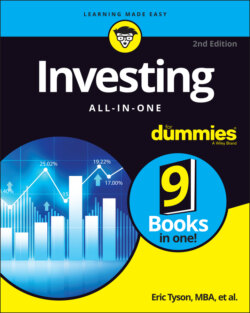Читать книгу Investing All-in-One For Dummies - Eric Tyson - Страница 146
Looking at important dates
ОглавлениеTo understand how buying stocks that pay dividends can benefit you as an investor, you need to know how companies report and pay dividends. Some important dates in the life of a dividend are as follows:
Date of declaration: This is the date when a company reports a quarterly dividend and the subsequent payment dates. On January 15, for example, a company may report that it “is pleased to announce a quarterly dividend of 50 cents per share to shareholders of record as of February 10.” That was easy. The date of declaration is really just the announcement date. Whether you buy the stock before, on, or after the date of declaration doesn’t matter in regard to receiving the stock’s quarterly dividend. The date that matters is the date of record (see that bullet later in this list).
Date of execution: This is the day you actually initiate the stock transaction (buying or selling). If you call up a broker (or contact one online) today to buy (or sell) a particular stock, then today is the date of execution, or the date on which you execute the trade. You don’t own the stock on the date of execution; it’s just the day you put in the order. For an example, skip to the following section.
Closing date (settlement date): This is the date on which the trade is finalized, which usually happens one business day after the date of execution. The closing date for stock is similar in concept to a real estate closing. On the closing date, you’re officially the proud new owner (or happy seller) of the stock.
Ex-dividend date: Ex-dividend means without dividend. Because it takes one day to process a stock purchase before you become an official owner of the stock, you have to qualify (that is, you have to own or buy the stock) before the one-day period. That one-day period is referred to as the “ex-dividend period.” When you buy stock during this short time frame, you aren’t on the books of record, because the closing (or settlement) date falls after the date of record. However, you will be able to buy the stock for a slightly lower price to offset the amount of the dividend. See the next section to see the effect that the ex-dividend date can have on an investor.
Date of record: This is used to identify which stockholders qualify to receive the declared dividend. Because stock is bought and sold every day, how does the company know which investors to pay? The company establishes a cut-off date by declaring a date of record. All investors who are official stockholders as of the declared date of record receive the dividend on the payment date, even if they plan to sell the stock any time between the date of declaration and the date of record.
Payment date: The date on which a company issues and mails its dividend checks to shareholders. Finally!
For typical dividends, the events in Table 1-2 happen four times per year.
TABLE 1-2 The Life of the Quarterly Dividend
| Event | Sample Date | Comments |
|---|---|---|
| Date of declaration | January 15 | The date that the company declares the quarterly dividend |
| Ex-dividend date | February 9 | Starts the one-day period during which, if you buy the stock, you don’t qualify for the dividend |
| Date of record | February 10 | The date by which you must be on the books of record to qualify for the dividend |
| Payment date | February 27 | The date that payment is made (a dividend check is issued and mailed to stockholders who were on the books of record as of February 10) |
